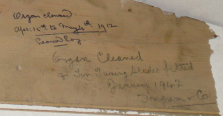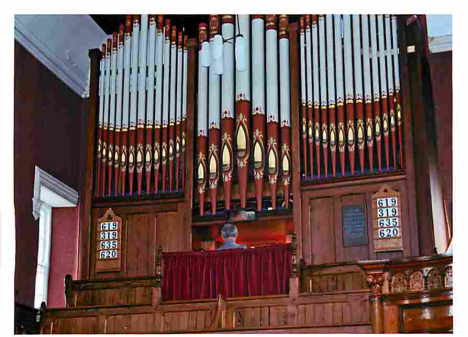 The organ at “The Plough” was built in 1897 by Ingram and Company of
Hereford and was installed the year after the opening of the present chapel.
Originally the air was supplied by a water-powered pump, much of which
survives, with a pump handle for back-up.
The organ at “The Plough” was built in 1897 by Ingram and Company of
Hereford and was installed the year after the opening of the present chapel.
Originally the air was supplied by a water-powered pump, much of which
survives, with a pump handle for back-up.

The organ was an “off the peg” instrument, there being others of the same
specification in the area. Empty stop holes on the Swell and Pedal
suggest that provision was made for the instrument to be extended at a later
stage but this didn’t happen until 2010. Early documents, however,
refer to it as being a “fine” organ.
A record of some of the previous work carried out and those responsible for
it was discovered in the top of the Swell box.

I first played the organ in May, 2006 and it was immediately obvious that
there was a problem and that there seemed to be significant air loss.
The organ tuning was badly out. The Swell and Great were not in tune
with each other and various stops, particularly the Swell Mixture were
totally unusable. The more stops drawn the worse the problem became.
Advice was sought from the then organ tuners- Henry Willis and Sons of
Liverpool. They prepared a report which spoke of major work done in
the 1980s which was all sound and well. The problem was that the
soundboards were failing badly and that these needed workshop attention.
In order to take them out the entire organ would have to be dismantled and
so a clean and some other minor repair work should, ideally, be undertaken
at the same time.
A second opinion was sought from The Clevedon Organ Company (formerly Percy
Daniels of Clevedon) which concluded much the same.
The Director of Music at Brecon Cathedral recommended that we ask Garry Owen
of GO Organs, also in Liverpool, to have a look. Garry had recently
taken over the care of the Cathedral Organ and the Cathedral staff had been
impressed by his work. He too identified the same problems and
remedies.
As all this progressed, and as different people looked at the organ it
became obvious that if major work was to be carried out then it would be
wonderful if some “stop” improvements could be made. There was no reed
or mutation on the Great and the Great “Piccolo” lacked brightness.
The Stopped Diapason was also of very similar volume and tonal quality to
the Open, both being made of metal and the Stopped Diapason suffered for a
significant and very noticeable tonal change at Middle C. The Swell
lacked a decent reed and the 16ft Pedal stop was extremely light, failing to
carry into the chapel and therefore failing to give the sound support.
Various ideas were considered and in the end it was decided to make the
following changes:
GREAT
The 2ft Piccolo was replaced with a 2ft Fifteenth, a straight swap on the
soundboard being all that was needed.
A new Twelfth should be added which could also be used with the Fifteenth to
make a 2 rank Mixture. There was no space on the Great soundboard to
add a new stop and so space had to be made for it. It took all of a
nanosecond to decide that the 8ft Dulciana should be sacrificed.
The 8 ft Stopped Diapason would be replaced so that we could get rid of the
change in tonal quality and the new stop would be quieter than the Open.
It would be replaced with a 2nd hand wooden rank of pipes, the original
having been metal, like the Open.
It was also decided to restore the original decoration to the front “case”
pipes. An original, black and white photograph showed that these had
been decorated according to the fashion of the late Victorian era.
This had been painted out during the 1960’s and the pipes had been repainted
in a single, rather dull, grey/blue colour. Part of the original
photograph was blown up to reveal the stencil pattern and detective work
showed small fragments of original paint colours remained on the back of
some of the pipes. It wasn’t a lot but a specialist firm was able to
work from it.
Part of the Gt Dulciana was on the case and this has been retained and acts
as the bottom octave for some of the Swell 8ft stops which used only to go
down to Tenor C.
SWELL
An 8ft Cornopean would be added to the Swell, the stop jamb filling one of
the vacant holes. From the position of the existing hole it had
clearly always been the original builder’s intention that such a stop should
be added. The blanked off space on the Swell soundboard made this a
simple job. The pipework came from the former Roath Park URC organ.
The bottom of the Swell 16ft was of smaller scale and this was replaced and
brought within the box.
Ideally we would have added a Sub Octave Coupler but since the action is
Tracker this was abandoned on grounds of both practicality and cost.
The organ’s action is very heavy and a Sub would also have made it even
heavier
PEDAL
With the pipes out it became obvious that some of the 16ft Pedal pipes were
actually 16ft Manuel pipes and that trying to “louden” them sufficiently was
just not possible. These were therefore replaced with actual Pedal
pipes.
A new 16ft open Wood was added as well which came from a redundant church,
St James, Newport Road, Cardiff. Fortunately there was just about
space in the chamber and there was already a hole in the right place for the
stop. A new chest for it had to be made. This was a significant
additional cost but had it not been done would have been a classic case of
spoiling the ship for a ha’p’orth of tar- albeit a big ha’p’orth.
After much thought it was decided to place the contract with GO Organs and
to award him the future tuning contract. Recommended by the Cathedral
and at a much lower cost than Willis we terminated the existing arrangement
with Henry Willis, thanking them for their help and support over the years.
Work began in July 2009 and it began not a moment too soon. The
decision had already been made to cease regular maintenance and to focus our
attention on the repair, clean and rebuild. By the time the work
started the organ was failing badly and loosing air horrendously. Few
stops were still usable and some had insufficient air reaching them to make
them sound. Covering up the problems was no longer possible.
So the organ was dismantled and repairs started to be undertaken. The
case pipes went off to Howell and Bellion in Saffron Walden and the chapel’s
hymnody was led by keyboard or by the chapel’s elderly baby grand piano,
itself in need of replacement. As the months went by it became
increasingly obvious just how much we took the organ for granted and just
how much we relied on it.
 In September 2009 the wind reservoir returned and in the second week of
November, 2009 a van drew up outside, loaded with all sorts of parts,
including the two soundboards which were unloaded. These had to be
manhandled into the building and up into the organ and the chapel’s
architecture made an already awkward job many times more difficult.
Members of the Rees family joined the organ builders and the job was done
with more speed, efficiency and good humour than could ever have been
expected. The place became a hive of activity and the
schoolroom was turned into a temporary workshop, canteen and rest area.
In September 2009 the wind reservoir returned and in the second week of
November, 2009 a van drew up outside, loaded with all sorts of parts,
including the two soundboards which were unloaded. These had to be
manhandled into the building and up into the organ and the chapel’s
architecture made an already awkward job many times more difficult.
Members of the Rees family joined the organ builders and the job was done
with more speed, efficiency and good humour than could ever have been
expected. The place became a hive of activity and the
schoolroom was turned into a temporary workshop, canteen and rest area.
The third week saw final workshop repairs being undertaken in Liverpool and
Garry attending to other commitments. Lights were added to the Swell
box and above the Great and then, at the end the case pipes returned and we
were able to see them in all their original glory.
Part of the organ came back into use in time for the Carol Service.
The congregation literally watched the last case pipes being put in as the
service started. Over the following months the organ gradually started
being reassembled and was completed in the summer of 2010.
Current Specification
Great
Swell
Open Diapason 8’
Viola 8”
Stopped Diapason 8’
Stopped Diapason 8’
Principal 4’
Voix Celeste
8’
Harmonic Flute 4’
Salicional 8’
Fifteenth
2’
Principal 4’
Twelfth
Oboe 8’
Horn 8’
Mixture (3 rnk)16’
Pedal
Bass Flute 8’ Couplers
Bourdon
16’
Open Wood 16’
Sw – Gt
Gt – Pd
Sw – Pd
Sw Octave
The Pedal couplers are of particular interest because they are not on the
stop jamb (as the Swell-Pedal and the Swell Octave are). Instead they are
under the swell keyboard as 4 thumb pistons, one to bring on and one to
cancel for each manual. They are actually quite well placed but do
catch out the unwary.
The action is extremely heavy, demanding of the player some precise
finger-work but the organ is capable of making some wonderful sounds, with
some particularly beautiful flutes and strings.
These notes were kindly provided by Revd Michael Hodgson
Minister at The Plough from 2006 - 2017